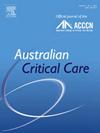Magnetic resonance imaging in comatose adults resuscitated after out-of-hospital cardiac arrest: A posthoc study of the Targeted Therapeutic Mild Hypercapnia after Resuscitated Cardiac Arrest trial
IF 2.6
3区 医学
Q2 CRITICAL CARE MEDICINE
引用次数: 0
Abstract
Background
Neuroimaging with magnetic resonance imaging (MRI) may assist clinicians in evaluating brain injury and optimising care in comatose adults resuscitated after out-of-hospital cardiac arrest (OHCA). However, contemporary international data on its use are lacking.
Aim
The primary aim was to compare the patient characteristics, early postresuscitation care, and neurological outcomes of patients according to MRI use.
Methods
We performed a posthoc analysis of the Targeted Therapeutic Mild Hypercapnia after Resuscitated Cardiac Arrest (TAME) trial, a multinational randomised trial comparing targeted mild hypercapnia or normocapnia in comatose adults after OHCA.
Results
After exclusions, 1639 patients enrolled in the TAME trial were analysed. Of these, 149 (9%) had an MRI. Compared to non-MRI patients, MRI patients were younger (58.9 versus 61.7 years, p: 0.02), had a longer median time from OHCA to return of spontaneous circulation (30 versus 25 min, p < 0.0001), and had a higher average arterial lactate level (8.78 versus 6.74 mmol/L, p < 0.0001) on admission to hospital. MRI patients were more likely to receive additional advanced diagnostic assessments during intensive care unit admission (p < 0.0001). At 6 months, 23 of 140 patients (16.4%) in the MRI group had a favourable neurological outcome, compared with 659 of 1399 patients (47.1%) in the no-MRI group (p < 0.001). On multivariable modelling, country of enrolment was the dominating predictor in the likelihood of an MRI being performed.
Conclusions
In the TAME trial, 9% of patients had an MRI during their intensive care unit admission. Among these patients, only 16% had a favourable neurological outcome at 6 months.
院外心脏骤停复苏后昏迷成人的磁共振成像:心脏骤停复苏后目标治疗性轻度高碳酸血症试验的事后研究。
背景:使用磁共振成像(MRI)进行神经成像可帮助临床医生评估脑损伤并优化院外心脏骤停(OHCA)后昏迷成人复苏后的护理。目的:主要目的是根据核磁共振成像的使用情况,比较患者的特征、复苏后早期护理和神经系统预后:我们对心脏骤停复苏后目标性治疗性轻度高碳酸血症(TAME)试验进行了事后分析,该试验是一项跨国随机试验,对 OHCA 后昏迷的成人进行了目标性轻度高碳酸血症或正常碳酸血症的比较:结果:在排除其他因素后,对参加 TAME 试验的 1639 名患者进行了分析。其中149人(9%)进行了核磁共振成像。与非核磁共振成像患者相比,核磁共振成像患者更年轻(58.9 岁对 61.7 岁,P:0.02),从 OHCA 到恢复自主循环的中位时间更长(30 分钟对 25 分钟,P:0.01):在 TAME 试验中,9% 的患者在入住重症监护病房期间接受了核磁共振成像检查。在这些患者中,只有 16% 的患者在 6 个月后获得了良好的神经功能预后。
本文章由计算机程序翻译,如有差异,请以英文原文为准。
求助全文
约1分钟内获得全文
求助全文
来源期刊

Australian Critical Care
NURSING-NURSING
CiteScore
4.90
自引率
9.10%
发文量
148
审稿时长
>12 weeks
期刊介绍:
Australian Critical Care is the official journal of the Australian College of Critical Care Nurses (ACCCN). It is a bi-monthly peer-reviewed journal, providing clinically relevant research, reviews and articles of interest to the critical care community. Australian Critical Care publishes peer-reviewed scholarly papers that report research findings, research-based reviews, discussion papers and commentaries which are of interest to an international readership of critical care practitioners, educators, administrators and researchers. Interprofessional articles are welcomed.
 求助内容:
求助内容: 应助结果提醒方式:
应助结果提醒方式:


